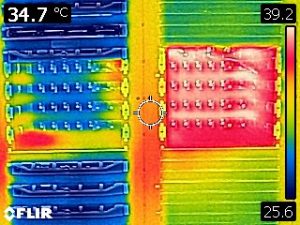Ask any data center manager and you’ll be told airflow management is of utter importance. Then why doesn’t it get the attention it deserves? Why is it so important to optimize your airflow? In general, it’s just a small gap in your server cabinet. Can’t be harmful, right?
Let’s start with some basic understanding of airflows within data centers. Nowadays almost all data centers apply hot and cold corridors to optimize the cooling capabilities. In the ideal situation cold air goes straight to the servers’ inlets. The hot air exiting the servers is returned directly to the cooling unit. This setup enables systems to run at the highest possible efficiency, using the least amount of power. The cooling setup has a big influence on the PUE (Power Usage Effectiveness): a lower PUE results in lower total energy consumption of the data center. This indirectly saves the environment and lowers OPEX costs. Could a small gap in your server rack really have that much influence?
As said above, the ideal setup is cold air entering the servers, while hot air exits. Gaps can lead to a higher demand of cold air than actually required by the servers. See it as a large water pipe: it normally needs a specific amount of water. When we make some holes in the pipe, you will need to pump in more water to get the same amount at the end of the pipe.
Another possibility is that hot air returns to the cold corridor, raising the temperature. This could cause cooling problems for the equipment. An example: a typical server requires 24 degrees Celsius of cold air to operate efficiently. The air getting out of the server might be warmed up to 40 degrees. In this example, there’s a gap close to the cold air inlet of the server that causes warm air going to the cold side. The cold air temperature rises from 24 to 30 degrees, and this could lead to problems with the servers.

(two cabinets with similar contents. The left one has good airflow management, the right one doesn’t)
Possible side-effects are:
- Server requires more power for its fans to keep the server from overheating
- Result: server is using more power than actually required
- Server overheats and fails
- Result: complete or partial loss of your server, at least downtime
- Server’s hardware components are stressed more
- Result: Life span of the server decreases
- Data centers need to produce more than the required amount of cooling capacity
- Result: Additional energy consumption, raising the data center’s PUE
- Raise of cold corridor temperature
- Agreed temperature SLA could be breached locally
What you can we do to improve airflow management?
- Use hot and cold corridors
- Always use blinding panels to close unused cabin space
- Even though they’re small: close cable cut-outs and other small gaps
- Check the alignment of server cabinets: are they exactly next to each other?
- Double check your server airflow inlet and exhaust (right airflow direction)
- Always (automatically) close the doors between the hot and cold corridor
- When removing a rack from a corridor: close the empty position immediately
Using a Cold or Hot corridor doesn’t matter, the separation of both air streams is the important part. Properly applied airflow management will bring forth higher efficiency and will lengthen the life span of your servers.
At datacenter.com we work together with our customers to optimize their airflow management. This enables us to improve the efficiency and performance of the servers, and lower the total amount of power our data center uses.
The picture is an example of one our customers in our Amsterdam data center. They asked our assistance in improving his airflow management. Needless to say, we jumped right in! We connected the customer with a potential supplier. The solution they came up with even saved the customer 60% compared to standard off the shelve airflow management kits! We take pride in bringing different suppliers and our customers together to find solutions for any requirement they have.
Some more information about cooling and airflow in a data center can be found in my other blog.
Hans Vreeburg, Datacenter Commissioning & Engineering Manager at Datacenter.com
